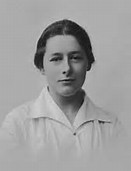
A switch to Neuropathology:
Dorothy met a young neurosurgeon at London Hospital- Hugh Cairns and he initiated her to take neuropathology as a career. With his help, she obtained a Rockefeller Fellowship to spend a year in North America, learning staining techniques applicable to the nervous system. She stayed few months at Boston with Frank Mallory (the trichrome and the PTAH fame !) and rest of the time at Montreal where she studied the origin of microglia, using metallic impregnation techniques. On her return to England in 1929, she took up Neuropathology as a full career. Much of the work that she did with Hugh Cairns and together they developed the squash smear techniques for the rapid intra-operative diagnosis in patients undergoing surgery for brain tumours.She also demonstrated the mode of glioma spread and collaborated in a number of clinico-pathological reports. At the same time Dorothy was performing experimental work as well as initiated cell cultures in her laboratory. She showed oligodendroglial cells undergo rhymic contractions in vitro.
Years between 1938-1943 were turbulent because of the world-war and this resulted in the disruption of Dorothy’s academic career to some extent However, during the war period, Dorothy was examing the brain on fatal head injuries and her research output in the war years was prodigious. She demonstrated the effects of brain tissue of antiseptics, widely used in the treatment of depressed skull fractures before penicillin became available, encapsulation of brain abscesses and formation of post traumatic intracranial cysts. She also demonstrated on the effects of synthetic materials used to repair for skull defects.
The ending of the war saw Dorothy return to Whitechapel and in 1946, she became the Director of the Institute of Pathology, first woman to hold a chair at an English university. She then focused herself on descriptive clinico-pathological work. Some of these include: effects of organic mercury poisoning on the brain, microgliomas, carcinomatous neuropathy and myopathy, the effects of surgical division of pituitary stalk, acute disseminated demyelinating encephalopathy, and slow virus diseases of the central nervous system.
In years, neuropathology was beginning to develop as a distinct speciality.In Britain, several newer generation of neuropathologists were trained with Dorothy. With the help other senior neuropathologists, a neuropathology club (later known as British Neuropathological Society) was formed. This was a forum where both clinical and experimental neuropathologists could meet regularly and discuss their work.Dorathy with the help of Rubinstein published a book ‘Pathology of tumours of nervous system’. This book provided the first text on brain tumurs which was both intelligible and comprehensive. This book went to five editions and remained the leading work even today.
It is easy to list Dorothy’s achievements as a Neuropathologist but less easy to say what she was like as person. She had a rather forbidding and sometimes aggressive public persona. As a result, many were in awe of her. Lucien Rubenstein, a close friend over three decades described her as a woman of ‘stately dignity’ and another colleague attributed her ‘rather masculine outer shell’ to barriers evolved by a woman who had succeeded in exclusively male dominated world. She was an epileptic and proved to the entire world that epilepsy need not be a bar to success. She retired in 1960 and thereafter took little part in British Neuropathology Society’s activities. She devoted herself to gardening and music. She left for heavenly abode in 1983.In her honour, British neuropathology society still conducts biennial memorial oration.
Though, Dorothy Russell left us behind almost 34 years ago, she will be remembered for one of her immortal and ever-lasting contribution-i.e. Toludine –blue stained squash smears for the rapid intra-operative diagnosis of brain tumors that we all practice every day in our routine practice.